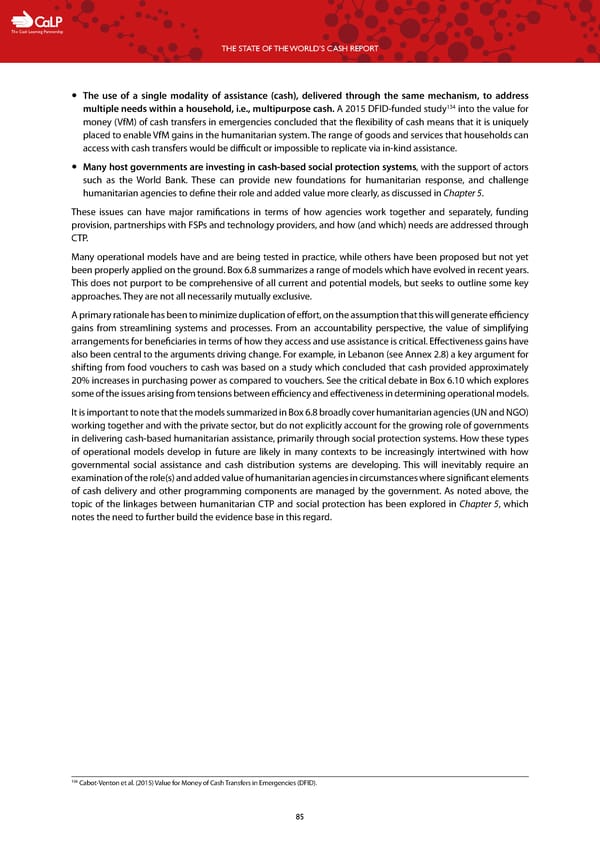C The Cash Learning Partnership THE STATE OF THE WORLD’S CASH REPORT — The use of a single modality of assistance (cash), delivered through the same mechanism, to address 134 multiple needs within a household, i.e., multipurpose cash. A 2015 DFID-funded study into the value for money (VfM) of cash transfers in emergencies concluded that the flexibility of cash means that it is uniquely placed to enable VfM gains in the humanitarian system. The range of goods and services that households can access with cash transfers would be difficult or impossible to replicate via in-kind assistance. — Many host governments are investing in cash-based social protection systems, with the support of actors such as the World Bank. These can provide new foundations for humanitarian response, and challenge humanitarian agencies to define their role and added value more clearly, as discussed in Chapter 5. These issues can have major ramifications in terms of how agencies work together and separately, funding provision, partnerships with FSPs and technology providers, and how (and which) needs are addressed through CTP. Many operational models have and are being tested in practice, while others have been proposed but not yet been properly applied on the ground. Box 6.8 summarizes a range of models which have evolved in recent years. This does not purport to be comprehensive of all current and potential models, but seeks to outline some key approaches. They are not all necessarily mutually exclusive. A primary rationale has been to minimize duplication of effort, on the assumption that this will generate efficiency gains from streamlining systems and processes. From an accountability perspective, the value of simplifying arrangements for beneficiaries in terms of how they access and use assistance is critical. Effectiveness gains have also been central to the arguments driving change. For example, in Lebanon (see Annex 2.8) a key argument for shifting from food vouchers to cash was based on a study which concluded that cash provided approximately 20% increases in purchasing power as compared to vouchers. See the critical debate in Box 6.10 which explores some of the issues arising from tensions between efficiency and effectiveness in determining operational models. It is important to note that the models summarized in Box 6.8 broadly cover humanitarian agencies (UN and NGO) working together and with the private sector, but do not explicitly account for the growing role of governments in delivering cash-based humanitarian assistance, primarily through social protection systems. How these types of operational models develop in future are likely in many contexts to be increasingly intertwined with how governmental social assistance and cash distribution systems are developing. This will inevitably require an examination of the role(s) and added value of humanitarian agencies in circumstances where significant elements of cash delivery and other programming components are managed by the government. As noted above, the topic of the linkages between humanitarian CTP and social protection has been explored in Chapter 5, which notes the need to further build the evidence base in this regard. 134 Cabot-Venton et al. (2015) Value for Money of Cash Transfers in Emergencies (DFID). 85
 The State of the World's Cash | Full Report Page 86 Page 88
The State of the World's Cash | Full Report Page 86 Page 88